Analysis of Health Impacts: 2011 Queensland Flood Disaster
VerifiedAdded on 2023/04/12
|5
|953
|474
Report
AI Summary
This report analyzes two research articles on the health impacts of the 2011 Queensland floods in Australia. The first article, by Alderman, Turner, and Tong (2013), assessed the physical and mental health impacts on residents of Brisbane, finding increased instances of post-traumatic stress disorder and sleep disorders. The study highlighted the significant toll of the floods on rural populations. The second article, by Austin et al. (2017), examined the effects of the floods on maternal stress and child development, revealing that prenatal maternal stress was not linked to the development of language and cognition of the toddler at thirty months, whereas maternal structuring and sensitivity were positively linked to toddler’s language and cognitive abilities. The research underscores the importance of emotional support and interventions for mothers during and after natural disasters to support their child's development. Both articles contribute to understanding the broad health consequences of natural disasters and the need for targeted interventions.
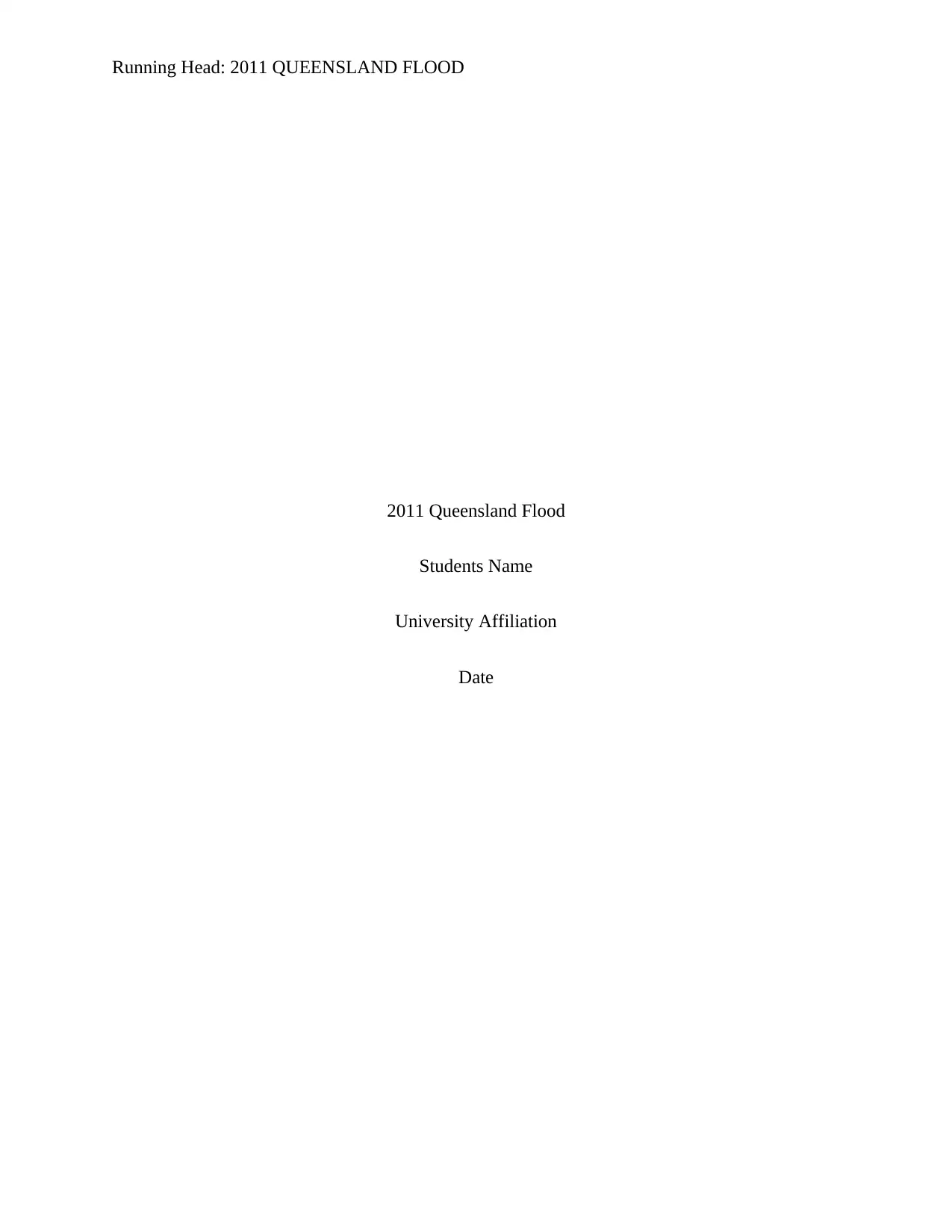
Running Head: 2011 QUEENSLAND FLOOD
2011 Queensland Flood
Students Name
University Affiliation
Date
2011 Queensland Flood
Students Name
University Affiliation
Date
Paraphrase This Document
Need a fresh take? Get an instant paraphrase of this document with our AI Paraphraser
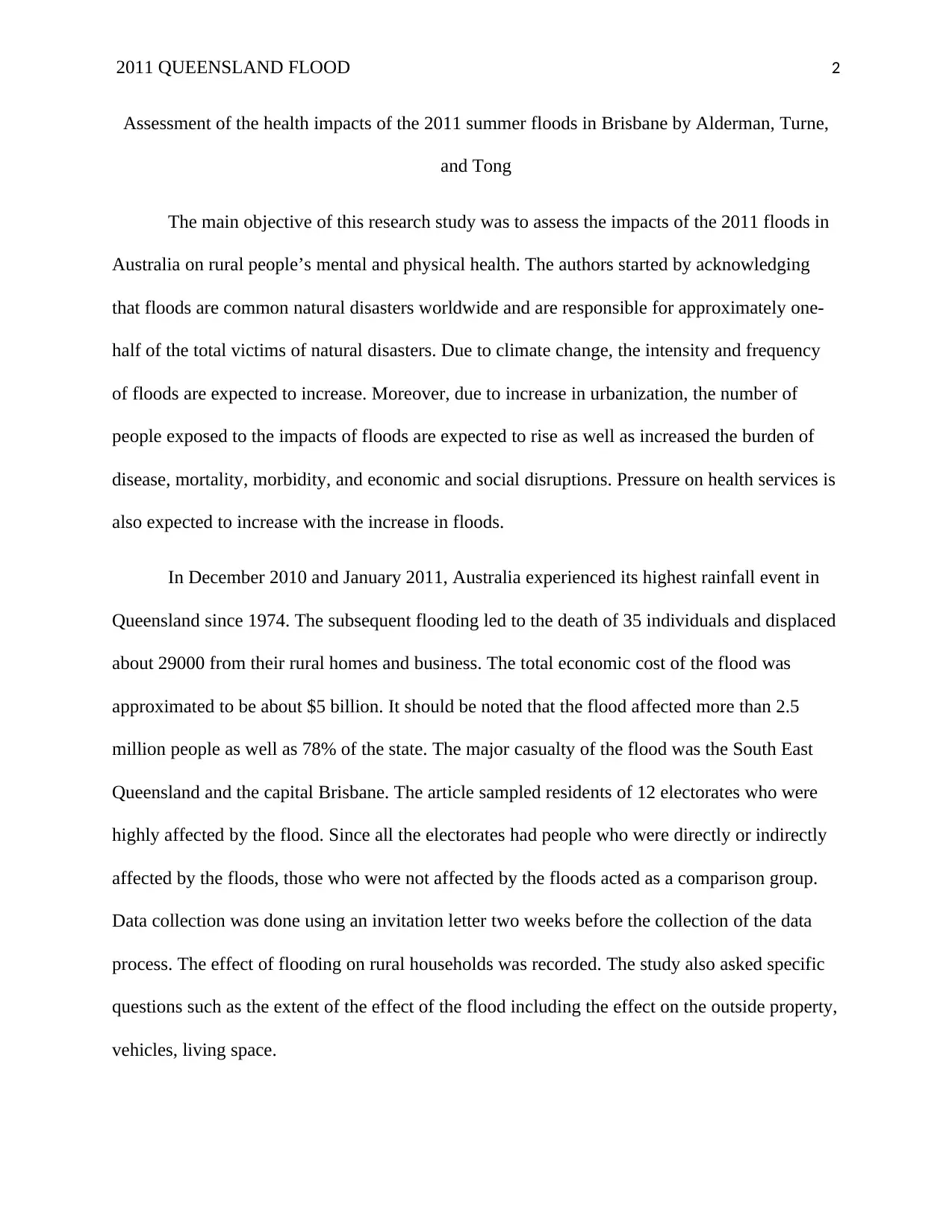
2011 QUEENSLAND FLOOD 2
Assessment of the health impacts of the 2011 summer floods in Brisbane by Alderman, Turne,
and Tong
The main objective of this research study was to assess the impacts of the 2011 floods in
Australia on rural people’s mental and physical health. The authors started by acknowledging
that floods are common natural disasters worldwide and are responsible for approximately one-
half of the total victims of natural disasters. Due to climate change, the intensity and frequency
of floods are expected to increase. Moreover, due to increase in urbanization, the number of
people exposed to the impacts of floods are expected to rise as well as increased the burden of
disease, mortality, morbidity, and economic and social disruptions. Pressure on health services is
also expected to increase with the increase in floods.
In December 2010 and January 2011, Australia experienced its highest rainfall event in
Queensland since 1974. The subsequent flooding led to the death of 35 individuals and displaced
about 29000 from their rural homes and business. The total economic cost of the flood was
approximated to be about $5 billion. It should be noted that the flood affected more than 2.5
million people as well as 78% of the state. The major casualty of the flood was the South East
Queensland and the capital Brisbane. The article sampled residents of 12 electorates who were
highly affected by the flood. Since all the electorates had people who were directly or indirectly
affected by the floods, those who were not affected by the floods acted as a comparison group.
Data collection was done using an invitation letter two weeks before the collection of the data
process. The effect of flooding on rural households was recorded. The study also asked specific
questions such as the extent of the effect of the flood including the effect on the outside property,
vehicles, living space.
Assessment of the health impacts of the 2011 summer floods in Brisbane by Alderman, Turne,
and Tong
The main objective of this research study was to assess the impacts of the 2011 floods in
Australia on rural people’s mental and physical health. The authors started by acknowledging
that floods are common natural disasters worldwide and are responsible for approximately one-
half of the total victims of natural disasters. Due to climate change, the intensity and frequency
of floods are expected to increase. Moreover, due to increase in urbanization, the number of
people exposed to the impacts of floods are expected to rise as well as increased the burden of
disease, mortality, morbidity, and economic and social disruptions. Pressure on health services is
also expected to increase with the increase in floods.
In December 2010 and January 2011, Australia experienced its highest rainfall event in
Queensland since 1974. The subsequent flooding led to the death of 35 individuals and displaced
about 29000 from their rural homes and business. The total economic cost of the flood was
approximated to be about $5 billion. It should be noted that the flood affected more than 2.5
million people as well as 78% of the state. The major casualty of the flood was the South East
Queensland and the capital Brisbane. The article sampled residents of 12 electorates who were
highly affected by the flood. Since all the electorates had people who were directly or indirectly
affected by the floods, those who were not affected by the floods acted as a comparison group.
Data collection was done using an invitation letter two weeks before the collection of the data
process. The effect of flooding on rural households was recorded. The study also asked specific
questions such as the extent of the effect of the flood including the effect on the outside property,
vehicles, living space.
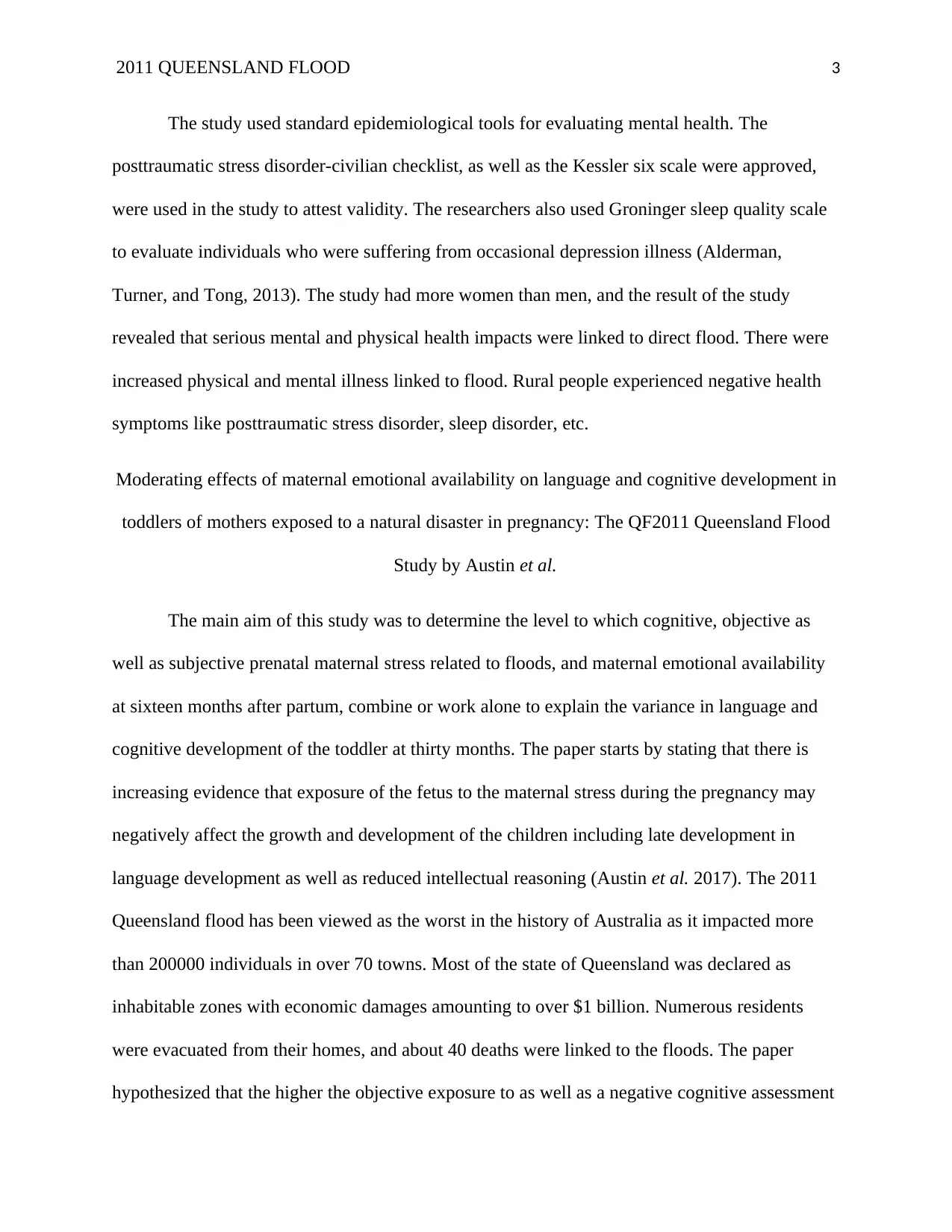
2011 QUEENSLAND FLOOD 3
The study used standard epidemiological tools for evaluating mental health. The
posttraumatic stress disorder-civilian checklist, as well as the Kessler six scale were approved,
were used in the study to attest validity. The researchers also used Groninger sleep quality scale
to evaluate individuals who were suffering from occasional depression illness (Alderman,
Turner, and Tong, 2013). The study had more women than men, and the result of the study
revealed that serious mental and physical health impacts were linked to direct flood. There were
increased physical and mental illness linked to flood. Rural people experienced negative health
symptoms like posttraumatic stress disorder, sleep disorder, etc.
Moderating effects of maternal emotional availability on language and cognitive development in
toddlers of mothers exposed to a natural disaster in pregnancy: The QF2011 Queensland Flood
Study by Austin et al.
The main aim of this study was to determine the level to which cognitive, objective as
well as subjective prenatal maternal stress related to floods, and maternal emotional availability
at sixteen months after partum, combine or work alone to explain the variance in language and
cognitive development of the toddler at thirty months. The paper starts by stating that there is
increasing evidence that exposure of the fetus to the maternal stress during the pregnancy may
negatively affect the growth and development of the children including late development in
language development as well as reduced intellectual reasoning (Austin et al. 2017). The 2011
Queensland flood has been viewed as the worst in the history of Australia as it impacted more
than 200000 individuals in over 70 towns. Most of the state of Queensland was declared as
inhabitable zones with economic damages amounting to over $1 billion. Numerous residents
were evacuated from their homes, and about 40 deaths were linked to the floods. The paper
hypothesized that the higher the objective exposure to as well as a negative cognitive assessment
The study used standard epidemiological tools for evaluating mental health. The
posttraumatic stress disorder-civilian checklist, as well as the Kessler six scale were approved,
were used in the study to attest validity. The researchers also used Groninger sleep quality scale
to evaluate individuals who were suffering from occasional depression illness (Alderman,
Turner, and Tong, 2013). The study had more women than men, and the result of the study
revealed that serious mental and physical health impacts were linked to direct flood. There were
increased physical and mental illness linked to flood. Rural people experienced negative health
symptoms like posttraumatic stress disorder, sleep disorder, etc.
Moderating effects of maternal emotional availability on language and cognitive development in
toddlers of mothers exposed to a natural disaster in pregnancy: The QF2011 Queensland Flood
Study by Austin et al.
The main aim of this study was to determine the level to which cognitive, objective as
well as subjective prenatal maternal stress related to floods, and maternal emotional availability
at sixteen months after partum, combine or work alone to explain the variance in language and
cognitive development of the toddler at thirty months. The paper starts by stating that there is
increasing evidence that exposure of the fetus to the maternal stress during the pregnancy may
negatively affect the growth and development of the children including late development in
language development as well as reduced intellectual reasoning (Austin et al. 2017). The 2011
Queensland flood has been viewed as the worst in the history of Australia as it impacted more
than 200000 individuals in over 70 towns. Most of the state of Queensland was declared as
inhabitable zones with economic damages amounting to over $1 billion. Numerous residents
were evacuated from their homes, and about 40 deaths were linked to the floods. The paper
hypothesized that the higher the objective exposure to as well as a negative cognitive assessment
⊘ This is a preview!⊘
Do you want full access?
Subscribe today to unlock all pages.

Trusted by 1+ million students worldwide
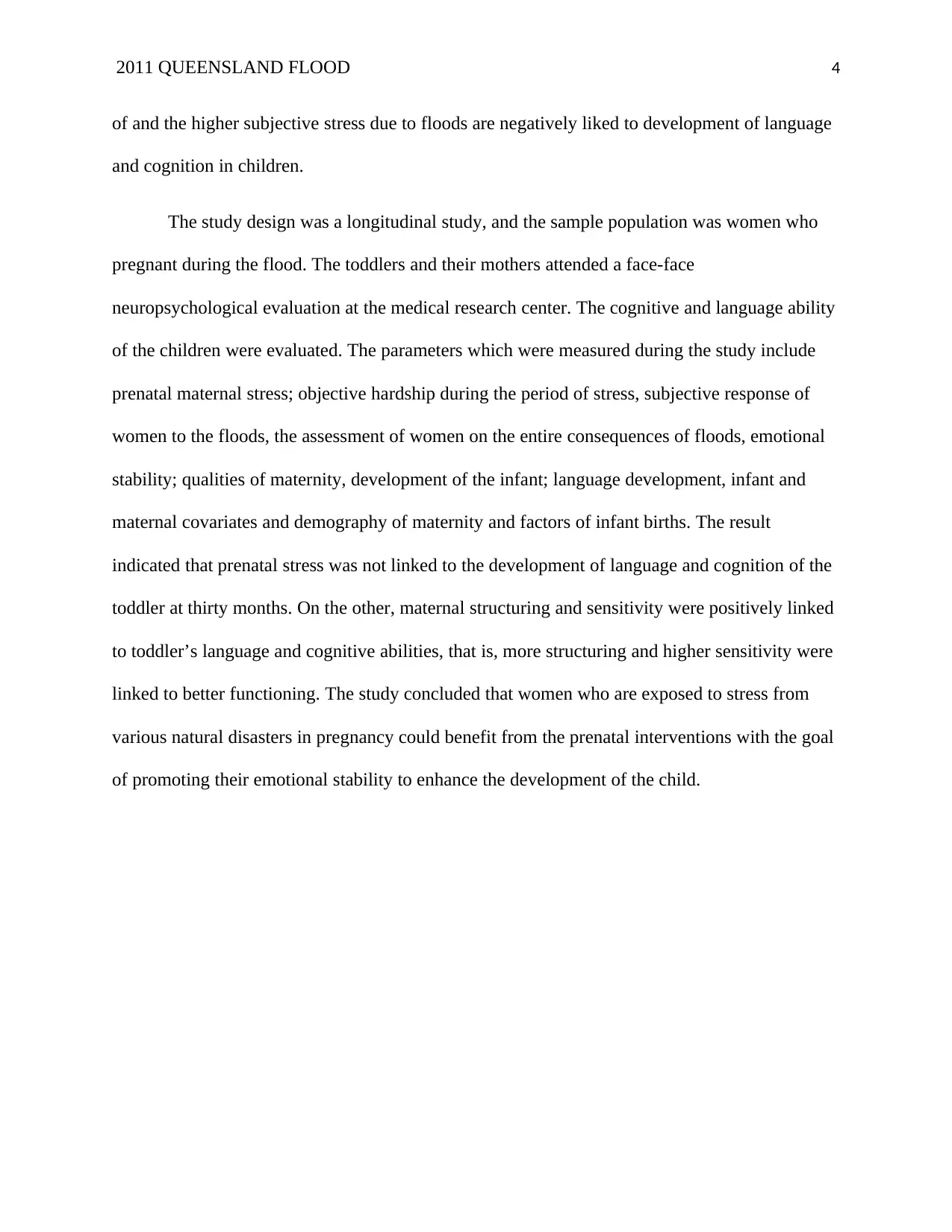
2011 QUEENSLAND FLOOD 4
of and the higher subjective stress due to floods are negatively liked to development of language
and cognition in children.
The study design was a longitudinal study, and the sample population was women who
pregnant during the flood. The toddlers and their mothers attended a face-face
neuropsychological evaluation at the medical research center. The cognitive and language ability
of the children were evaluated. The parameters which were measured during the study include
prenatal maternal stress; objective hardship during the period of stress, subjective response of
women to the floods, the assessment of women on the entire consequences of floods, emotional
stability; qualities of maternity, development of the infant; language development, infant and
maternal covariates and demography of maternity and factors of infant births. The result
indicated that prenatal stress was not linked to the development of language and cognition of the
toddler at thirty months. On the other, maternal structuring and sensitivity were positively linked
to toddler’s language and cognitive abilities, that is, more structuring and higher sensitivity were
linked to better functioning. The study concluded that women who are exposed to stress from
various natural disasters in pregnancy could benefit from the prenatal interventions with the goal
of promoting their emotional stability to enhance the development of the child.
of and the higher subjective stress due to floods are negatively liked to development of language
and cognition in children.
The study design was a longitudinal study, and the sample population was women who
pregnant during the flood. The toddlers and their mothers attended a face-face
neuropsychological evaluation at the medical research center. The cognitive and language ability
of the children were evaluated. The parameters which were measured during the study include
prenatal maternal stress; objective hardship during the period of stress, subjective response of
women to the floods, the assessment of women on the entire consequences of floods, emotional
stability; qualities of maternity, development of the infant; language development, infant and
maternal covariates and demography of maternity and factors of infant births. The result
indicated that prenatal stress was not linked to the development of language and cognition of the
toddler at thirty months. On the other, maternal structuring and sensitivity were positively linked
to toddler’s language and cognitive abilities, that is, more structuring and higher sensitivity were
linked to better functioning. The study concluded that women who are exposed to stress from
various natural disasters in pregnancy could benefit from the prenatal interventions with the goal
of promoting their emotional stability to enhance the development of the child.
Paraphrase This Document
Need a fresh take? Get an instant paraphrase of this document with our AI Paraphraser
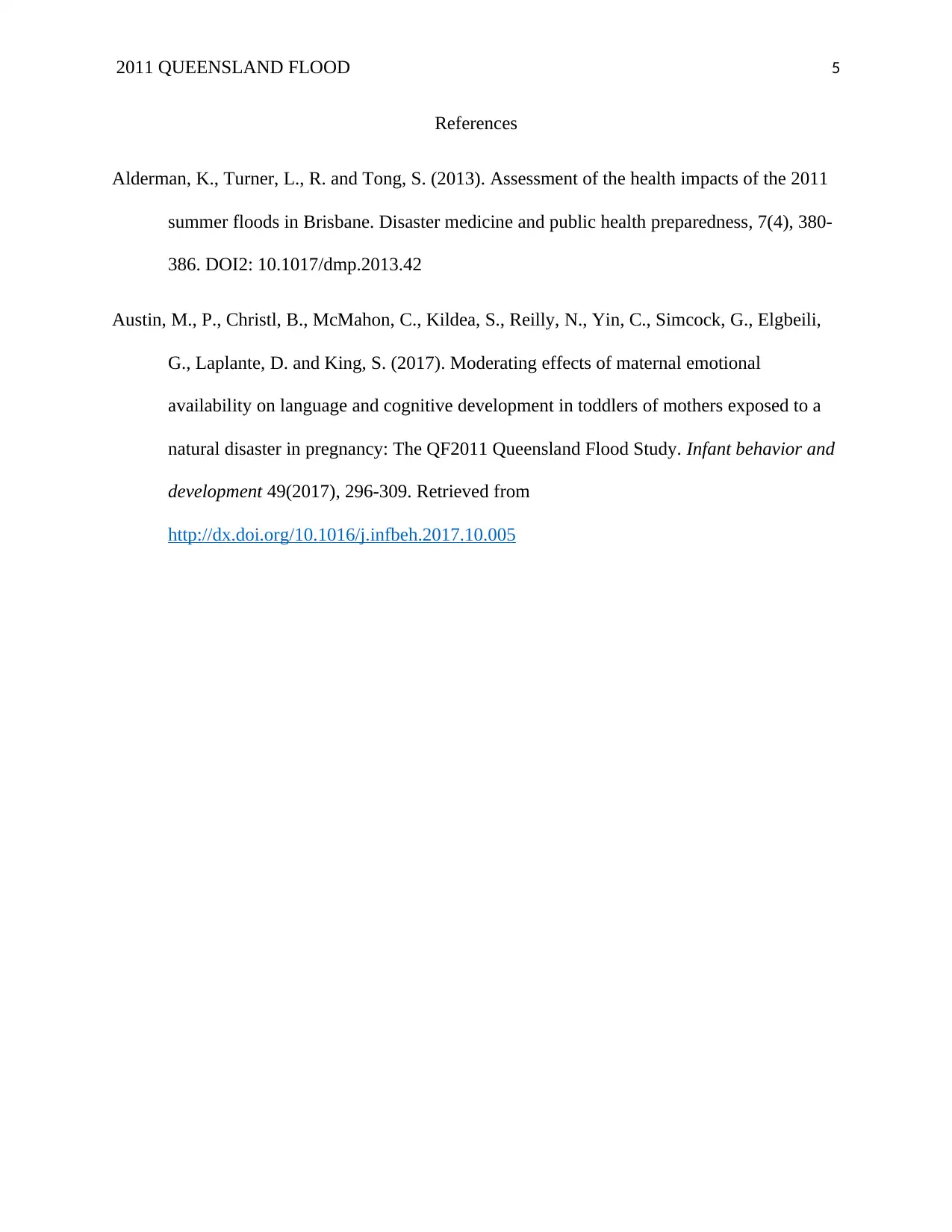
2011 QUEENSLAND FLOOD 5
References
Alderman, K., Turner, L., R. and Tong, S. (2013). Assessment of the health impacts of the 2011
summer floods in Brisbane. Disaster medicine and public health preparedness, 7(4), 380-
386. DOI2: 10.1017/dmp.2013.42
Austin, M., P., Christl, B., McMahon, C., Kildea, S., Reilly, N., Yin, C., Simcock, G., Elgbeili,
G., Laplante, D. and King, S. (2017). Moderating effects of maternal emotional
availability on language and cognitive development in toddlers of mothers exposed to a
natural disaster in pregnancy: The QF2011 Queensland Flood Study. Infant behavior and
development 49(2017), 296-309. Retrieved from
http://dx.doi.org/10.1016/j.infbeh.2017.10.005
References
Alderman, K., Turner, L., R. and Tong, S. (2013). Assessment of the health impacts of the 2011
summer floods in Brisbane. Disaster medicine and public health preparedness, 7(4), 380-
386. DOI2: 10.1017/dmp.2013.42
Austin, M., P., Christl, B., McMahon, C., Kildea, S., Reilly, N., Yin, C., Simcock, G., Elgbeili,
G., Laplante, D. and King, S. (2017). Moderating effects of maternal emotional
availability on language and cognitive development in toddlers of mothers exposed to a
natural disaster in pregnancy: The QF2011 Queensland Flood Study. Infant behavior and
development 49(2017), 296-309. Retrieved from
http://dx.doi.org/10.1016/j.infbeh.2017.10.005
1 out of 5
Your All-in-One AI-Powered Toolkit for Academic Success.
+13062052269
info@desklib.com
Available 24*7 on WhatsApp / Email
![[object Object]](/_next/static/media/star-bottom.7253800d.svg)
Unlock your academic potential
Copyright © 2020–2025 A2Z Services. All Rights Reserved. Developed and managed by ZUCOL.


